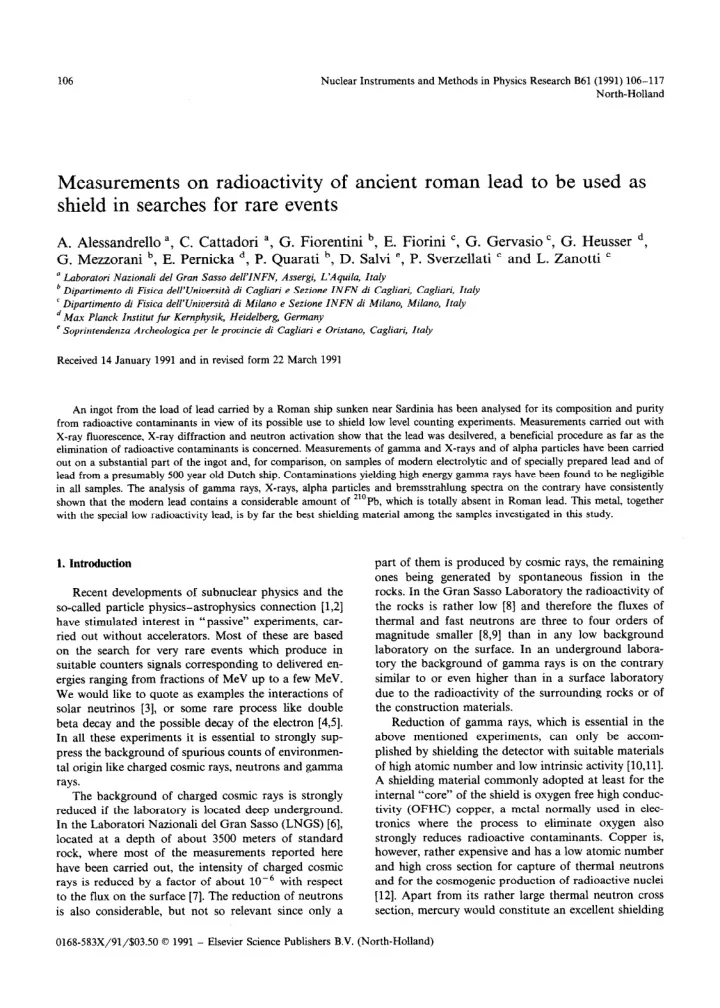

106 Nuclear Instruments and Methods in Physics Research B61(1991) 106-117 North-Holland Measurements on radioactivity of ancient roman lead to be used as shield in searches for rare events A. Alessandrello a, C. Cattadori a, G. Fiorentini b, E. Fiorini ‘, G. Gervasio ‘, G. Heusser d, G. Mezzorani b, E. Pernicka d, P. Quarati b, D. Salvi e, P. Sverzellati ’ and L. Zanotti ’ ’ Loboratori Nazionaii de1 Gran Sa~so dell’fNFN, Assergi, L’Aquila, Ita& ’ ~ipariime~to di Fisica de~~u~ivers~t~ di Cagliari e Sezione INFN di CagEor& Cagliari, Ita@ ’ ~ipartime~to di Fisica del~~~iversit~ di ~iiano e Sezione INFN di Milana, M~lono~ Itaiy d Max Plunck Institut jiir Kern.5h~sik, Heidelberg, Germany e Soprintendenta Archeologica per le provincie di Cagliari e Oristano, Cugliari, Italy Received 14 January 1991 and in revised form 22 March 1991 An ingot from the load of lead carried by a Roman ship sunken near Sardinia has been anaiysed for its composition and purity from radioactive contaminants in view of its possible use to shield low level counting experiments. Measurements canied out with X-ray fluorescence, X-ray diffraction and neutron activation show that the lead was desilvered, a beneficial procedure as far as the elimination of radioactive contaminants is concerned. Measurements of gamma and X-rays and of alpha particles have been carried out on a substantial part of the ingot and, for comparison, on samples of modern electrolytic and of specially prepared lead and of lead from a presumably 500 year old Dutch ship. Co~ta~nations yielding high energy gamma rays have been found to be negligible in all sampIes. The analysis of gamma rays, X-rays, atpha particles and bremsstrahlung spectra on the contrary have consistently shown that the modem lead contains a considerable amount of “‘Pb, which is totally absent in Roman lead. This metal, together with the special low radioactivity lead, is by far the best shielding material among the samples investigated in this study. zyxwvutsrqponmlkjihgfedcbaZYXWVUTSRQPONMLKJIHGFEDCBA 1. Introduction part of them is produced by cosmic rays, the remaining ones being generated by spontaneous fission in the Recent developments of sub~uclear physics and the rocks. In the Gran Sasso Laboratory the radioactivity of so-called particle physics-astrophysics connection fl,2] the rocks is rather low f8] and therefore the fluxes of thermal and fast neutrons are three to four orders of have stimulated interest in “passive” experiments, car- ried out without accelerators. Most of these are based magnitude smaller [8,9] than in any low background laboratory on the surface. In an underground labora- on the search for very rare events which produce in suitable counters signals corresponding to delivered en- tory the background of gamma rays is an the contrary ergies ranging from fractions of MeV up to a few MeV. similar to or even higher than in a surface laboratory We would like to quote as examples the interactions of due to the radioactivity of the surrounding rocks or of solar neutrinos [3], or some rare process like double the construction materials. beta decay and the possible decay of the electron [4,5]. Reduction of gamma rays, which is essential in the In all these experiments it is essential to strongly sup- above mentioned experiments, can only be accom- press the background of spurious counts of environmen- plished by shielding the detector with suitable materials of high atomic number and low intrinsic activity [lO,ll]. tal origin like charged cosmic rays, neutrons and gamma A s~elding material commonly adopted at least for the rays. The background of charged cosmic rays is strongly internal “core” of the shield is oxygen free high conduc- reduced if the laboratory is located deep underground. tivity (OFHC) copper, a metal normally used in elec- In the Laboratori Nazionali de1 Gran Sasso (LNGS) [6], tronics where the process to eliminate oxygen also strongly reduces radioactive contaminants. Copper is, located at a depth of about 3500 meters of standard however, rather expensive and has a low atomic number rock, where most of the measu~ments reported here have been carried out, the intensity of charged cosmic and high cross section for capture of thermal neutrons rays is reduced by a factor of about 10e6 with respect and for the cosmogenic production of radioactive nuclei to the flux on the surface [7]. The reduction of neutrons 1121. Apart from its rather large thermal neutron cross is also considerable, but not so relevant since only a section, mercury would constitute an excellent shielding 0168-583X/91/$03.50 0 1991 - Elsevier Science Publishers B.V. (North-Holland)
Recommend
More recommend